by Peter Starr
photography by the author and Thom Tyre
Forty years ago I lived in Vancouver and was a successful rock-and-roll radio DJ. Fresh from England with the appropriately thick accent, I was on a first-name basis with many of the top English rock icons. I pretty much had it made, or at least had it relatively easy. At the time, Trev Deeley was the Triumph distributor, and since I had spent four years at the Triumph factory, it was not long before I drifted over to Deeley’s, introduced myself and was back in the saddle again.
About that time I met and became friends with Thom Tyre, then a nonmotorcyclist but nonetheless an all-round good guy whose interest in music mirrored my tenure at CKLG radio. I remember fixing Thom up with a lady friend of mine and taking them to the short-track races in Bellingham, Washington, to watch a then-unknown named Steve Baker, who later became America’s first-ever roadracing World Champion. Well, Thom married the lady who was his blind date, and we are still best friends 40 years later! To celebrate those 40 years Thom and I decided to take a four-day ride into British Columbia’s interior—the Okanagan Valley.
Vancouver has become a very different place since I was there in the ’60s. It is a large cosmopolitan city with traffic jams, immigration issues and drug and gang crime challenges, much like a smaller L.A. But underneath this is a strong European value-driven attitude that is just across our border, yet quite different from us.
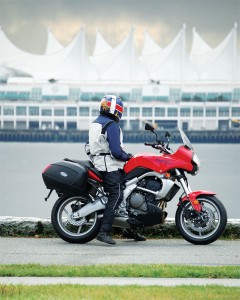
I wanted to start the ride by going north along the coast to Horseshoe Bay, then to Whistler Mountain before heading for the Okanagan Valley through Pemberton and Lillooet. It is a very picturesque route that I thought would give us some great photo ops, but the road to Whistler was being modified to accommodate the 2010 Olympic Winter Games and the traffic was interrupted with considerable and unpredictable waits. Also, it was raining—one of BC’s frequent weather conditions—so we decided to head east as fast as possible.
The Fraser River runs east and west through the main valley. The main roads and railway follow its path. Within an hour we had left Vancouver’s metropolitan area and were riding into the verdant farming communities of Abbotsford and Chilliwack. Hope was a short distance farther along the Trans-Canada Highway, where it and we headed north avoiding the quite scenic but—from a rider’s perspective—boring Coquihalla Highway toll road. Speed limits in B.C. are controlled by the Mounties (RCMP), and they do pop up out of seemingly nowhere with their radar guns in the instant-on mode.
The road followed the Fraser River’s path and I could only imagine that on a sunny day it would be visually stunning. But the rain had caught up with us and dampened the experience. Lytton could not have come soon enough. By then the weather had lightened a little and we wove our way to Spences Bridge with a smile, masking my chattering teeth before heading southeast along Highway 8 to Merritt, where clean sheets and a hot tub awaited! Merritt is the self-proclaimed Country Music Capital of Canada and attracts 150,000 people-plus each year to a music festival to hear the likes of Reba McIntyre, Tanya Tucker and The Mavericks.
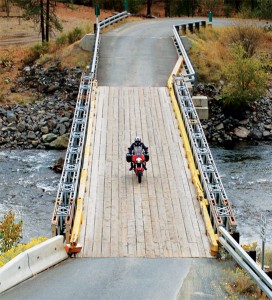
I was riding a 2008 Kawasaki Versys, a 400-pound, fuel-injected, 650cc parallel twin that has a style separating it from anything currently on the U.S. market. It has great ground clearance, real tractable power and a versatile character that I found very appealing. I earned my racing stripes aboard parallel twins, so this formula has always appealed to me. The Givi bags are oh-so easy to use and designed specifically for the Versys, too. Is it Kawasaki’s rhetorical challenge to the not-so rhetorical statement, “Been there, done that!”? The hanging seductive response is “Perhaps not?”
I expected cool weather, it being early autumn and all, but nothing drastic. I was wrong. It was cold and I was not as prepared as I should have been. But the roads were fantastic and the scenery commanding enough that the cold was only a modest distraction. Thom’s bike had heated grips and an accessory outlet for a heated vest. He was laughing!
The road from Merritt to Kamloops is stimulating, twisty, two-lane blacktop that parallels the south shore of Nicola Lake and the north bank of a number of rivers. Nicola was an influential Indian chief. His native name, Hwistesmet-quen, was not for the pronunciation-challenged fur traders of the early 1800s, so they called him Nicholas. The lake and river named after him have excellent fly-fishing if you have the time and inclination. Fourteen miles northeast of Merritt is the majestic Quilchena Hotel (pronounced quill-shana). Built by pioneer rancher Joseph Guichon to serve the carriage trade between Nicola and Kamloops, it first opened its doors in 1908.
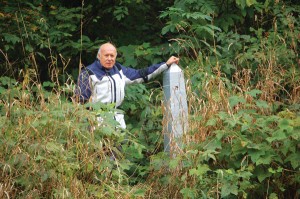
At Kamloops we stopped in to see one of the most eclectic motorcycle artisans I have ever known, Peter Smith. He builds sidecars and everything that goes with them, including the very unique front suspension for one of my camera bikes. Like me, he is an ex-Brit who learned his skills the hard way. People all over the USA seek his services, and many travel to this very hard-to-reach place just to pay sidecar homage. “Chez-Smith” at Kamloops is not the kind of place you just “stumble upon.” You need to be on a mission to get there.
With the Smiths in my rearview mirror, Saturday afternoon was much kinder to us. Even though we rode through two intense rainstorms in quick succession, the sun paid us a welcome visit as we stopped for lunch at a renowned biker bar in the village of Falkland. It is decorated with photos of real old bikers and life-sized wooden sculptures of bikes. Stopping for the occasional photo op, we dodged the showers and chased rainbows all the way to Vernon, then rode south to Kelowna on the south shore of the Okanagan Lake to end my second day in the Versys’ saddle.
The Okanagan Lake, surrounded by semi-arid hills and plateaus, is 104 miles long and in places reaches a depth of more than 990 feet. It is home to an infamous and elusive water creature, Ogopogo, which supposedly lives on the bottom of the lake. Ogopogo dates back to the First Nations (Indian) people arriving in this area. This snakelike creature has been around for hundreds of years, and the sightings still continue. Ogopogo has become part of BC folklore, and is a protected species under the provincial wildlife act. Can you say “Nessie”?
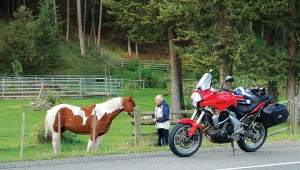
The fall equinox occurred on September 23rd and was accompanied by smells and visual cues of approaching autumn that we just don’t get some 1,500 miles south in the desert community of southern California. Thom and I spent our third day exploring the environs of Kelowna, including a climb up Knox Mountain, home of the annual Knox Mountain Hillclimb for cars.
At the base of the hill the unmistakable aroma of horse chestnut trees about to unload their payload of fruit reminded me of the days 55 years ago when we played “conkers” as schoolboys in England. Within the fruit’s spiky protective shell is a nut called the conker. We would drill a hole though the conker and thread a string through the hole. Then while one of us held his string dangling the conker, the opposing player would try to strike the opposing player’s conker with his own. One of them would inevitably break and the winner would survive to hit and be hit another day. There is a lot to reminisce about when you are about to turn 65!
Day Four started out warm and sunny as we crossed the rickety bridge to the west bank of the lake and headed in a circuitous route back to Vancouver. The west bank is liberally sprinkled with glorious vineyards and subsequently—you guessed it—wineries and wine tasting. Our journey took us to Summerland and Penticton before heading southwest to the little town of Keremeos. The air was clean and fresh and still a little chilled. It had a certain edge to it that made you think it had to be healthy to take deep breaths. The hedgerows were full of luscious, juicy sweet blackberries that the local birds had not yet relieved from their thorny clusters.
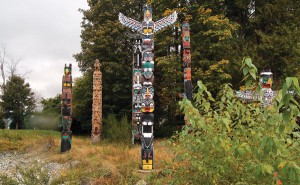
The 650 Versys was a delight galloping through the sweeping bends as we climbed to the mountain passes that border the lake country along Highway 3A. The temperature dropped to 2 degrees C, too close to freezing for my liking, and for the first time I felt uncomfortable. But offsetting this was the visual feast of the countryside through which we were riding.
The Okanagan Valley is the fruit basket of Canada, with grapes (mainly for wine), apples, pears, peaches and then in season, pumpkins. In the charming little town of Keremeos, there were pumpkins everywhere, and quite honestly, precious little else! We hightailed it west to Manning Park, a very popular ski resort in winter, for our lunch stop. It is not unusual to see bear, deer and elk in this neighborhood so careful riding, with a constant scan of the side of the road, is a must.
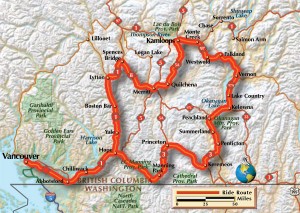
The last part of our almost 1,000-mile ride took us along the U.S./Canada border on Avenue 0, where there are no guards. Aluminum-bronze monuments mark the 49th parallel at every mile, from the Georgia Strait in B.C. to Lake of the Woods in Ontario, as defined by treaty in 1846.
As I get older it becomes even more important to take these kinds of rides with friends who play an important role in one’s life. All too often now I find that it is easy not to spend that time, and all too easy to miss out on the bountiful experience that motorcycling and true friendship brings. As Thom and I toasted this ride in traditional fashion, I noticed large bunches of bright-red yew berries on a tree near his house, a sure sign that fall was truly here and winter would not be far behind. Not the greatest time to go on a long ride in British Columbia, but one that filled us with copious memories for the long winter nights.
[From the September 2008 issue of Rider]






